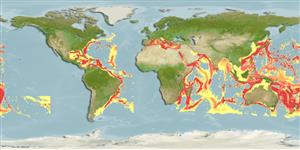Common names from other countries
Classification / Names / Names
Nomi Comuni | Sinonimi | Catalog of Fishes (gen., sp.) | ITIS | CoL | WoRMS
Environment: milieu / climate zone / depth range / distribution range
Ecologia
; distribuzione batimetrica 0 - 3890 m (Ref. 102521). Tropical
Circumglobal.
Length at first maturity / Size / Peso / Age
Maturity: Lm ? range ? - ? cm
Notable in tropical and subtropical coastal fouling communities (Ref. 102523). Found among living corals as well as on the underside of dead corals. Buried in the skeleton of Montastraea sp. while also seen attached to a dead Pocillopora damicornis (Ref. 102066). Filter feeds to extract minute plankton and organic matter from water column (Ref. 107862).
Life cycle and mating behavior
Maturità | Riproduzione | Deposizione | Uova | Fecundity | Larve
Members of the class Polychaeta are gonochoric (sexual), gametes are spawned through the metanephridia or body wall rupturing.
Coles, S.L., R.C. DeFelice, L.G. Eldredge and J.T. Carlton. 1999. (Ref. 3356)
IUCN Red List Status (Ref. 130435)
CITES status (Ref. 108899)
Not Evaluated
Not Evaluated
Human uses
| FishSource |
Strumenti
Informazioni ulteriori
Age/Size
Accrescimento
Length-weight
Length-length
Morfologia
Larve
Abbondanza
Fonti Internet
Estimates based on models
Preferred temperature
(Ref.
115969): 3 - 13, mean 4.8 (based on 2429 cells).
Price category
Unknown.
